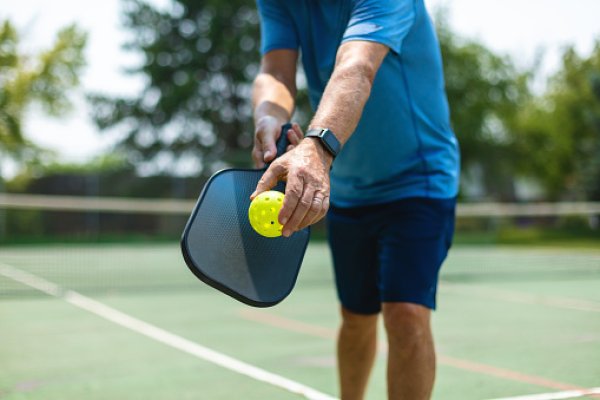Ever wondered how to add a bit of flair to your pickleball game? Well, I’m here to introduce you to the art of the spin serve. It’s a technique that can give you an edge over your competitors, and it’s not as hard to master as you might think.
Spin serves in pickleball are all about finesse and strategy. They’re not just about making the ball spin, but about making it unpredictable for your opponent. A well-executed spin serve can keep your rivals guessing and put you in control of the game.
So, if you’re looking to up your pickleball game, you’ve come to the right place. In this article, I’ll break down the basics of spin serves, explain how they can improve your game, and give you some tips to get started. Let’s dive into the world of pickleball spin serves.
What is a spin serve in pickleball?
A spin serve in pickleball is a unique serve that involves the manipulation of the ball to create disorienting effects. It’s more than just making the ball revolve around its axis. It’s a strategic play designed to confuse or disrupt an opponent’s timing and rhythm.
Spin serves require an understanding of physics and a knack for execution. It’s all about how you strike the ball and the angle of your paddle upon impact. There are multiple types of spin serves, each with distinct characteristics that affect the ball’s movement and bounce. These include:
- Topspin serve: where the ball spins forward as it moves through the air. This serve creates a sharp, low bounce, making it harder for the opponent to return.
- Backspin serve: where the ball spins backward. Backspin serves often cause the ball to bounce away from the opponent, throwing them off balance.
- Sidespin serve: where the ball spins horizontally. A sidespin serve can be particularly deceptive as it moves left or right, disrupting the opponent’s anticipation.
All these variations serve to infuse the gameplay with a degree of unpredictability. They compel the opponent to respond quickly, often leading to mistakes or weak returns.
But spin serves aren’t just about flustering the opponent. They also allow players to showcase their technical prowess. Executing a perfect spin serve is a testament to one’s understanding of the game’s mechanics and their ability to manipulate it to their advantage. It takes practice, accuracy, and precision to accomplish.
Though intimidating at first, learning and perfecting these serves can both up your game and make it more fun. Even beginners can get the hang of it with enough practice, making it a must-try for every pickleball player out there.
In the following sections, we’ll delve deeper into the benefits of spin serves and provide tips to help you get started.
Why should you use a spin serve?
The allure of using spin serves in your pickleball game isn’t just about showcasing your skills. It’s more about leveraging the elements of unpredictability and surprise that come with them.
The Unpredictable Movement – By fiddling around with topspin, sidespin, and backspin, each hit becomes a mystery for your opponent. Watching a ball move in an unanticipated manner can lead to confusion, inducing a weak return or even result in an outright mistake. Your ability to master these spins and stealthily incorporate them into your serve could significantly enhance your winning chances.
Creating Weak Returns – With the ball spinning unpredictably, most players react in an abrupt or unorganized manner. Their returns tend to be weak, offering you an excellent opportunity to seize control of the game. A well-executed spin serve can corner your opponent, limiting their movements and restricting their striking options.
A Display of Technical Prowess – There’s no denying that executing a perfect spin serve symbolizes a player’s authority over the game. It affirms the knowledge and mastery of the game’s mechanics and denotes a subtle yet powerful message to opponents about your technical superiority.
Moreover, incorporating spin into your serves brings an element of fun and thrills to your game. Every time you smash a spin serve, and it dips and turns in a way that baffles your opponent, it brings a sense of accomplishment and enjoyment.
So now, you understand why you should use a spin serve. Let’s look at some basic steps on how to add spin to your serve.
Learning to perform spin serves could well make you a formidable player, and definitely, a more rigorous and cunning opponent to face on the pickleball court. Yet, getting your spin serves right requires practice. The coming section will guide you through the essential spin serve techniques, so stay tuned.
Different types of spin serves
In pickleball, players use a variety of spin serves to outwit and outmaneuver their opponents. When it comes to executing a spin on the ball, a few different variations can create a unique challenge for opponents. Let’s dive deeper into a few of these.
The first type of spin serve is the topspin serve. Common in other racket sports like tennis or table tennis, this serve sees the ball spinning forward from the server to the receiver. It’s a highly effective move that results in the ball dipping down onto the court quickly after crossing the net.
Next, there’s the backspin serve. This is when the ball spins backward from the server to the receiver. It’s a tricky move to execute well, but when done right, it can cause the ball to bounce low, making it difficult for an opponent to return effectively.
The slice serve is another variation worth noting. This type of serve involves hitting the ball in such a way that it spins sideways, making it swerve in the air. Mastering this serve can make a significant difference in throwing off your opponents’ timing.
But let’s not forget the final type that’s a mix of topspin and sidespin, called the kick serve. This serve bounces high and in an unexpected direction upon landing, making it a favorite among advanced players looking to add another layer of unpredictability to their serves.
Here’s a quick summary of the different types of spin serves:
| Types of Spin Serves | Description |
|---|---|
| Topspin serve | Spins forward, dips down onto the court quickly |
| Backspin serve | Spins backward, bounces low |
| Slice serve | Spins sideways, swerves in the air |
| Kick serve | Bounces high and in an unexpected direction |
Remember that mastering these different types of serves takes time, practice, and patience. Try practicing each of them and see how they can add a unique twist to your pickleball game.
How to execute a spin serve
Executing a spin serve in pickleball might seem like a tall order but with the right technique and plenty of practice, you’ll be adding this element to your game in no time. It’s all about the flick of your wrist and the follow-through of your arm.
When it comes to a topspin serve, the key lies in the upward brush of the ball. Start with your paddle below the ball and slice up and through it during the serve. This gives the ball an upward rotation, making it dip downwards onto the court more rapidly.
For the backspin serve, you’ll need an opposite motion. This time start with your paddle above the ball and slice down and through it. A cutting or chopping action is what you’re aiming for to give the ball a backspin. This makes the ball bounce lower, which can catch your opponents off guard.
Next is the slice serve, a personal favorite of many players. For this, you need to brush the ball’s side while serving it. This imparts a sideways spin and makes it swerve in the air. It’s a tricky serve that often confuses opponents, causing them to misjudge the ball’s trajectory.
The kick serve, widely regarded as the trickiest serve in pickleball, requires a combination of topspin and side spin. For this, hit the ball with an upward and sideways motion so it spins forward as well as sideways. The result – a ball that bounces high and in a different direction, making it hard for your competitors to return.
As you can see from our examples, much depends on the motion of your wrist and paddle during a serve. While we’ve provided a starting point for mastering these serves, it’s important to know the process of incorporating them into your game will take time and patience. Be sure to experiment with different angles and contact points on the paddle to find what works best for you.
To make the process of learning these serves a tad easier, I’ll be putting together a resource guide soon. It will be packed with tips, tricks, and drills designed to boost your serving game. Hopefully, it’ll help you in your quest for pickleball domination.
Tips for mastering the spin serve
From my years of experience, response time and paddle grip are two aspects that heavily affect the outcome of a spin serve in Pickleball.
Response Time
Reacting to your opponent’s shot is vital in every sport, and Pickleball is no different. Particularly when it comes to spin serves: quicker response time can both save the point and put you on the offensive.
There isn’t necessarily a magic formula for improving it, but practicing under different scenarios can certainly help. Here’s how:
- Practice with partners of varying skill levels to accustom yourself to different serve styles.
- Try rapid-fire drills where you have to return multiple quick serves in succession.
- Experiment with different types of serves to learn how to read and react to them faster.
Paddle Grip
A proper grip on your paddle can drastically affect the spin on the ball. I tend to use the eastern grip which provides more control and better spin on serve. But remember, that’s just my preference.
There are several other grips you could try as well, like:
- The western grip
- The semi-western grip
- The continental grip
Each of these grips can let you serve the ball with a different angle and spin speed. So don’t hesitate to experiment and find the one that suits your style best.
The effective command of these two aspects will considerably up your serving game. Remember, perfection comes with lots of practice. So keep experimenting and don’t forget to have fun!
In the next section, I’ll be putting together a resource guide to help readers improve their serving game.
Conclusion
Mastering the spin serve in pickleball is no small feat. It’s about honing your response time and choosing the right paddle grip. I’ve shared insights on how practicing with diverse partners, engaging in rapid-fire drills, and experimenting with various serves can enhance your game. I’ve also highlighted the impact of different paddle grips like the eastern, western, semi-western, and continental on the ball’s spin. Remember, it’s not just about learning; it’s about practicing and evolving. Keep striving, and soon you’ll see your serving game reach new heights. Stay tuned for the upcoming resource guide designed to assist you further in your pickleball journey. Here’s to a stronger, more strategic spin serve!














0 Comments